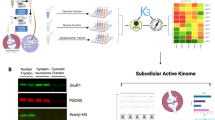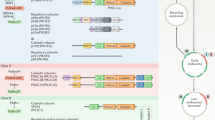Abstract
Specificity in cell signalling can be influenced by the targeting of different enzyme combinations to substrates. The A-kinase anchoring protein AKAP79/150 is a multivalent scaffolding protein that coordinates the subcellular localization of second-messenger-regulated enzymes, such as protein kinase A, protein kinase C and protein phosphatase 2B. We developed a new strategy that combines RNA interference of the endogenous protein with a protocol that selects cells that have been rescued with AKAP79/150 forms that are unable to anchor selected enzymes. Using this approach, we show that AKAP79/150 coordinates different enzyme combinations to modulate the activity of two distinct neuronal ion channels: AMPA-type glutamate receptors and M-type potassium channels. Utilization of distinct enzyme combinations in this manner provides a means to expand the repertoire of cellular events that the same AKAP modulates.
This is a preview of subscription content, access via your institution
Access options
Subscribe to this journal
Receive 12 print issues and online access
$209.00 per year
only $17.42 per issue
Buy this article
- Purchase on Springer Link
- Instant access to full article PDF
Prices may be subject to local taxes which are calculated during checkout







Similar content being viewed by others
Accession codes
References
Venter, J. C. et al. The sequence of the human genome. Science 291, 1304–1351 (2001).
Lander, E. S. et al. Initial sequencing and analysis of the human genome. Nature 409, 860–921 (2001).
Hunter, T. Signaling — 2000 and beyond. Cell 100, 113–127 (2000).
Pawson, T. & Nash, P. Assembly of cell regulatory systems through protein interaction domains. Science 300, 445–452 (2003).
Wong, W. & Scott, J. D. AKAP signalling complexes: Focal points in space and time. Nature Rev. Mol. Cell Biol. 5, 959–971 (2004).
Carr, D. W., Stofko-Hahn, R. E., Fraser, I. D. C., Cone, R. D. & Scott, J. D. Localization of the cAMP-dependent protein kinase to the postsynaptic densities by A-kinase anchoring proteins: characterization of AKAP79. J. Biol. Chem. 24, 16816–16823 (1992).
Klauck, T. M. et al. Coordination of three signaling enzymes by AKAP79, a mammalian scaffold protein. Science 271, 1589–1592 (1996).
Gao, T. et al. cAMP-dependent regulation of cardiac L-type Ca2+ channels requires membrane targeting of PKA and phosphorylation of channel subunits. Neuron 19, 185–196 (1997).
Fraser, I. D. & Scott, J. D. Modulation of ion channels: a 'current' view of AKAPs. Neuron 23, 423–426 (1999).
Hoshi, N. et al. AKAP150 signaling complex promotes suppression of the M-current by muscarinic agonists. Nature Neurosci. 6, 564–571 (2003).
Banke, T. G. et al. Control of GluR1 AMPA receptor function by cAMP-dependent protein kinase. J. Neurosci. 20, 89–102 (2000).
Esteban, J. A. et al. PKA phosphorylation of AMPA receptor subunits controls synaptic trafficking underlying plasticity. Nature Neurosci. 6, 136–143 (2003).
Tavalin, S. J. et al. Regulation of GluR1 by the A-kinase anchoring protein 79 (AKAP79) signaling complex shares properties with long-term depression. J. Neurosci. 22, 3044–3051 (2002).
Carr, D. W., Hausken, Z. E., Fraser, I. D., Stofko-Hahn, R. E. & Scott, J. D. Association of the type II cAMP-dependent protein kinase with a human thyroid RII-anchoring protein. Cloning and characterization of the RII-binding domain. J. Biol. Chem. 267, 13376–13382 (1992).
Faux, M. C. & Scott, J. D. Regulation of the AKAP79-protein kinase C interaction by Ca2+/calmodulin. J. Biol. Chem. 272, 17038–17044 (1997).
Dell'Acqua, M. L., Dodge, K. L., Tavalin, S. J. & Scott, J. D. Mapping the protein phosphatase-2B anchoring site on AKAP79. Binding and inhibition of phosphatase activity are mediated by residues 315–360. J. Biol. Chem. 277, 48796–48802 (2002).
Garner, C. C., Nash, J. & Huganir, R. L. PDZ domains in synapse assembly and signalling. Trends Cell Biol. 10, 274–280 (2000).
Brown, D. A. & Adams, P. R. Muscarinic suppression of a novel voltage-sensitive K+ current in a vertebrate neurone. Nature 283, 673–676 (1980).
Marrion, N. V. Control of M-current. Annu. Rev. Physiol. 59, 483–504 (1997).
Suh, B. C. & Hille, B. Recovery from muscarinic modulation of M current channels requires phosphatidylinositol 4,5-bisphosphate synthesis. Neuron 35, 507–520 (2002).
Zhang, H. et al. PIP(2) activates KCNQ channels, and its hydrolysis underlies receptor-mediated inhibition of M currents. Neuron 37, 963–975 (2003).
Bosma, M. M. & Hille, B. Protein kinase C is not necessary for peptide-induced suppression of M current or for desensitization of the peptide receptors. Proc. Natl Acad. Sci. USA 86, 2943–2947 (1989).
Cruzblanca, H., Koh, D. S. & Hille, B. Bradykinin inhibits M current via phospholipase C and Ca2+ release from IP3-sensitive Ca2+ stores in rat sympathetic neurons. Proc. Natl Acad. Sci. USA 95, 7151–7156 (1998).
Dell'Acqua, M. L., Faux, M. C., Thorburn, J., Thorburn, A. & Scott, J. D. Membrane-targeting sequences on AKAP79 bind phosphatidylinositol-4, 5- bisphosphate. EMBO J. 17, 2246–2260 (1998).
Edwards, A. S. & Newton, A. C. Phosphorylation at conserved carboxyl-terminal hydrophobic motif regulates the catalytic and regulatory domains of protein kinase C. J. Biol. Chem. 272, 18382–18390 (1997).
Smith, W. B., Starck, S. R., Roberts, R. W. & Schuman, E. M. Dopaminergic stimulation of local protein synthesis enhances surface expression of GluR1 and synaptic transmission in hippocampal neurons. Neuron 45, 765–779 (2005).
Marrion, N. V. Calcineurin regulates M channel modal gating in sympathetic neurons. Neuron 16, 163–173 (1996).
Cooper, E. C. et al. Colocalization and coassembly of two human brain M-type potassium channel subunits that are mutated in epilepsy. Proc. Natl Acad. Sci. USA 97, 4914–4919 (2000).
Westphal, R. S. et al. Regulation of NMDA receptors by an associated phosphatase-kinase signaling complex. Science 285, 93–96 (1999).
Acknowledgements
We thank J. J. Carlisle Michel and R. Goodman for insightful comments on the manuscript and R. Mouton for technical assistance. This work was supported by grant no. GM48231 from the National Institutes of Health to J.D.S.
Author information
Authors and Affiliations
Corresponding author
Ethics declarations
Competing interests
The authors declare no competing financial interests.
Supplementary information
Supplementary Information
Supplementary figures S1, S2, S3 and S4 (PDF 419 kb)
Rights and permissions
About this article
Cite this article
Hoshi, N., Langeberg, L. & Scott, J. Distinct enzyme combinations in AKAP signalling complexes permit functional diversity. Nat Cell Biol 7, 1066–1073 (2005). https://doi.org/10.1038/ncb1315
Received:
Accepted:
Published:
Issue Date:
DOI: https://doi.org/10.1038/ncb1315
This article is cited by
-
A-Kinase Anchoring Protein 79/150 Scaffolds Transient Receptor Potential A 1 Phosphorylation and Sensitization by Metabotropic Glutamate Receptor Activation
Scientific Reports (2017)
-
Modulation of Kv7 channels and excitability in the brain
Cellular and Molecular Life Sciences (2017)
-
Identification and classification of small molecule kinases: insights into substrate recognition and specificity
BMC Evolutionary Biology (2016)
-
Signalling scaffolds and local organization of cellular behaviour
Nature Reviews Molecular Cell Biology (2015)
-
Role of calmodulin in neuronal Kv7/KCNQ potassium channels and epilepsy
Frontiers in Biology (2014)



